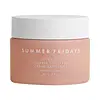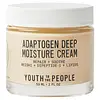What's inside
What's inside
 Key Ingredients
Key Ingredients

 Benefits
Benefits

 Concerns
Concerns

 Ingredients Side-by-side
Ingredients Side-by-side

Water
Skin ConditioningPropanediol
SolventDicaprylyl Carbonate
EmollientGlycerin
HumectantPentylene Glycol
Skin ConditioningSodium Hyaluronate
HumectantHydrolyzed Sodium Hyaluronate
Skin ConditioningGlycine
BufferingSerine
MaskingGlutamic Acid
HumectantAspartic Acid
MaskingLeucine
Skin ConditioningAlanine
MaskingLysine
Skin ConditioningArginine
MaskingTyrosine
MaskingPhenylalanine
MaskingProline
Skin ConditioningThreonine
Valine
MaskingIsoleucine
Skin ConditioningHistidine
HumectantAscorbic Acid
AntioxidantSaccharide Isomerate
HumectantHaematococcus Pluvialis Extract
AntioxidantCeramide NP
Skin ConditioningTocopheryl Acetate
AntioxidantTocopherol
AntioxidantHexapeptide-11
Skin ConditioningPalmitoyl Tripeptide-1
Skin ConditioningAnanas Sativus Fruit Extract
Skin ConditioningSaccharomyces/Magnesium Ferment
Saccharomyces/Copper Ferment
Skin ConditioningSaccharomyces/Silicon Ferment
Skin ConditioningButylene Glycol
HumectantGlyceryl Acrylate/Acrylic Acid Copolymer
HumectantGlyceryl Caprylate
EmollientSucrose Stearate
EmollientLecithin
EmollientPolyglyceryl-10 Laurate
Skin ConditioningXanthan Gum
EmulsifyingCetearyl Olivate
Sorbitan Olivate
EmulsifyingSodium Citrate
BufferingCarbomer
Emulsion StabilisingCitric Acid
BufferingCetearyl Alcohol
EmollientSodium Hydroxide
BufferingLactobacillus Ferment
Skin ConditioningLeuconostoc/Radish Root Ferment Filtrate
AntimicrobialHydroxyacetophenone
AntioxidantCI 77491
Cosmetic ColorantWater, Propanediol, Dicaprylyl Carbonate, Glycerin, Pentylene Glycol, Sodium Hyaluronate, Hydrolyzed Sodium Hyaluronate, Glycine, Serine, Glutamic Acid, Aspartic Acid, Leucine, Alanine, Lysine, Arginine, Tyrosine, Phenylalanine, Proline, Threonine, Valine, Isoleucine, Histidine, Ascorbic Acid, Saccharide Isomerate, Haematococcus Pluvialis Extract, Ceramide NP, Tocopheryl Acetate, Tocopherol, Hexapeptide-11, Palmitoyl Tripeptide-1, Ananas Sativus Fruit Extract, Saccharomyces/Magnesium Ferment, Saccharomyces/Copper Ferment, Saccharomyces/Silicon Ferment, Butylene Glycol, Glyceryl Acrylate/Acrylic Acid Copolymer, Glyceryl Caprylate, Sucrose Stearate, Lecithin, Polyglyceryl-10 Laurate, Xanthan Gum, Cetearyl Olivate, Sorbitan Olivate, Sodium Citrate, Carbomer, Citric Acid, Cetearyl Alcohol, Sodium Hydroxide, Lactobacillus Ferment, Leuconostoc/Radish Root Ferment Filtrate, Hydroxyacetophenone, CI 77491
Water
Skin ConditioningGlycerin
HumectantEthyl Oleate
EmollientCentaurea Cyanus Flower Water
Skin ConditioningNiacinamide
SmoothingGlyceryl Stearate Citrate
EmollientBehenyl Alcohol
EmollientLauryl Laurate
Skin ConditioningButyrospermum Parkii Butter
Skin ConditioningAmmonium Polyacryloyldimethyl Taurate
Emulsion StabilisingInonotus Obliquus Extract
Skin ConditioningTremella Fuciformis Polysaccharide
Emulsion StabilisingAcetyl Dipeptide-1 Cetyl Ester
Skin ConditioningGanoderma Lucidum Extract
Skin ProtectingLinoleic Acid
CleansingLinolenic Acid
CleansingOleic Acid
EmollientPhytic Acid
Sodium Hydroxide
BufferingStearic Acid
CleansingWithania Somnifera Root Extract
Skin ConditioningPanthenol
Skin ConditioningTocopherol
AntioxidantCeramide NP
Skin ConditioningC12-16 Alcohols
EmollientHydrogenated Lecithin
EmulsifyingPalmitic Acid
EmollientSimmondsia Chinensis Seed Oil
EmollientSqualane
EmollientArginine
MaskingCaprylyl Glycol
EmollientCitric Acid
BufferingCoco-Betaine
CleansingEthylhexylglycerin
Skin ConditioningFructose
HumectantHelianthus Annuus Seed Oil
EmollientPropanediol
SolventXanthan Gum
EmulsifyingCaramel
Cosmetic ColorantBenzyl Alcohol
PerfumingPhenoxyethanol
PreservativePotassium Sorbate
PreservativeWater, Glycerin, Ethyl Oleate, Centaurea Cyanus Flower Water, Niacinamide, Glyceryl Stearate Citrate, Behenyl Alcohol, Lauryl Laurate, Butyrospermum Parkii Butter, Ammonium Polyacryloyldimethyl Taurate, Inonotus Obliquus Extract, Tremella Fuciformis Polysaccharide, Acetyl Dipeptide-1 Cetyl Ester, Ganoderma Lucidum Extract, Linoleic Acid, Linolenic Acid, Oleic Acid, Phytic Acid, Sodium Hydroxide, Stearic Acid, Withania Somnifera Root Extract, Panthenol, Tocopherol, Ceramide NP, C12-16 Alcohols, Hydrogenated Lecithin, Palmitic Acid, Simmondsia Chinensis Seed Oil, Squalane, Arginine, Caprylyl Glycol, Citric Acid, Coco-Betaine, Ethylhexylglycerin, Fructose, Helianthus Annuus Seed Oil, Propanediol, Xanthan Gum, Caramel, Benzyl Alcohol, Phenoxyethanol, Potassium Sorbate
 Reviews
Reviews

Ingredients Explained
These ingredients are found in both products.
Ingredients higher up in an ingredient list are typically present in a larger amount.
Arginine is an amino acid that is important for human development. Your body uses is it to produce hair keratin and skin collagen.
As a cosmetic ingredient, Arginine has antioxidant properties and can also help repair damaged skin. This ingredient is derived either synthetically or from animals.
Arginine isn't fungal acne safe when used in the presence of other lipids (fats, fatty acids, oils, esters, etc). Oils and fats occur naturally within the skin, so take caution when using Arginine if you're prone to fungal acne.
Learn more about ArginineCeramide NP is a type of ceramide and formally known as ceramide 3.
Ceramides are intercellular lipids naturally found in our skin that bonds dead skin cells together to create a barrier. They are known for their ability to hold water and thus are a great ingredient for dry skin.
Ceramides are an important building block for our skin barrier. A stronger barrier helps the skin look more firm and hydrated. By bolstering the skin ceramides act as a barrier against irritating ingredients. This can help with inflammation as well.
If you would like to eat ceramides, sweet potatoes contain a small amount.
Read more about other common types of ceramides here:
Ceramide AP
Ceramide EOP
Citric Acid is an alpha hydroxy acid (AHA) naturally found in citrus fruits like oranges, lemons, and limes.
Like other AHAs, citric acid can exfoliate skin by breaking down the bonds that hold dead skin cells together. This helps reveal smoother and brighter skin underneath.
However, this exfoliating effect only happens at high concentrations (20%) which can be hard to find in cosmetic products.
Due to this, citric acid is usually included in small amounts as a pH adjuster. This helps keep products slightly more acidic and compatible with skin's natural pH.
In skincare formulas, citric acid can:
While it can provide some skin benefits, research shows lactic acid and glycolic acid are generally more effective and less irritating exfoliants.
Most citric acid used in skincare today is made by fermenting sugars (usually from molasses). This synthetic version is identical to the natural citrus form but easier to stabilize and use in formulations.
Read more about some other popular AHA's here:
Learn more about Citric AcidGlycerin is already naturally found in your skin. It helps moisturize and protect your skin.
A study from 2016 found glycerin to be more effective as a humectant than AHAs and hyaluronic acid.
As a humectant, it helps the skin stay hydrated by pulling moisture to your skin. The low molecular weight of glycerin allows it to pull moisture into the deeper layers of your skin.
Hydrated skin improves your skin barrier; Your skin barrier helps protect against irritants and bacteria.
Glycerin has also been found to have antimicrobial and antiviral properties. Due to these properties, glycerin is often used in wound and burn treatments.
In cosmetics, glycerin is usually derived from plants such as soybean or palm. However, it can also be sourced from animals, such as tallow or animal fat.
This ingredient is organic, colorless, odorless, and non-toxic.
Glycerin is the name for this ingredient in American English. British English uses Glycerol/Glycerine.
Learn more about GlycerinPropanediol is an all-star ingredient. It softens, hydrates, and smooths the skin.
It’s often used to:
Propanediol is not likely to cause sensitivity and considered safe to use. It is derived from corn or petroleum with a clear color and no scent.
Learn more about PropanediolSodium Hydroxide is also known as lye or caustic soda. It is used to adjust the pH of products; many ingredients require a specific pH to be effective.
In small amounts, sodium hydroxide is considered safe to use. However, large amounts may cause chemical burns due to its high alkaline.
Your skin has a natural pH and acid mantle. This acid mantle helps prevent harmful bacteria from breaking through. The acid mantle also helps keep your skin hydrated.
"Alkaline" refers to a high pH level. A low pH level would be considered acidic.
Learn more about Sodium HydroxideTocopherol (also known as Vitamin E) is a common antioxidant used to help protect the skin from free-radicals and strengthen the skin barrier. It's also fat soluble - this means our skin is great at absorbing it.
Vitamin E also helps keep your natural skin lipids healthy. Your lipid skin barrier naturally consists of lipids, ceramides, and fatty acids. Vitamin E offers extra protection for your skin’s lipid barrier, keeping your skin healthy and nourished.
Another benefit is a bit of UV protection. Vitamin E helps reduce the damage caused by UVB rays. (It should not replace your sunscreen). Combining it with Vitamin C can decrease sunburned cells and hyperpigmentation after UV exposure.
You might have noticed Vitamin E + C often paired together. This is because it is great at stabilizing Vitamin C. Using the two together helps increase the effectiveness of both ingredients.
There are often claims that Vitamin E can reduce/prevent scarring, but these claims haven't been confirmed by scientific research.
Learn more about TocopherolWater. It's the most common cosmetic ingredient of all. You'll usually see it at the top of ingredient lists, meaning that it makes up the largest part of the product.
So why is it so popular? Water most often acts as a solvent - this means that it helps dissolve other ingredients into the formulation.
You'll also recognize water as that liquid we all need to stay alive. If you see this, drink a glass of water. Stay hydrated!
Learn more about WaterXanthan gum is used as a stabilizer and thickener within cosmetic products. It helps give products a sticky, thick feeling - preventing them from being too runny.
On the technical side of things, xanthan gum is a polysaccharide - a combination consisting of multiple sugar molecules bonded together.
Xanthan gum is a pretty common and great ingredient. It is a natural, non-toxic, non-irritating ingredient that is also commonly used in food products.
Learn more about Xanthan Gum